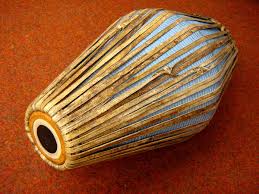Search Topic
Khol Indian authentic musical instrument

Khol the ethnic folk musical instrument was originated from West Bengal, Assam & Manipur. The folk instrument mainly used for the devotional numbers of the eastern & north eastern state of India, from which it has been taken in shape. Another name of the Khol is Mridanga, which means made of clay. Which describes the main component of the instrument. It is widely used percussion instrument in eastern India.
It is a barrel shaped asymmetrical double skin drum, with a hollow earthen body. It is so similar to the ancient Gopuchha shape of drums, as described in his Natya Shastra. It was with heads at both ends, one far smaller than the other. The heads of Khol are of different sizes.
The right face of the drum, which is approximately three to five inches in diameter, has a high pitch and produces a metallic sound, whereas the left face, which is six to eight inches in diameter, produces a lower bass sound. Both the faces have a double leather layer at the outer rim. They are tighten by a leather strap. The relation between the two faces is almost of an octave.
108 different categories of taal available for the offbeat instrument. The khol is made of fixed pitches. Alteration in tuning is not possible. Few special syllables of Khol are Ta, Deta, Dhoi, Jhan, Tit etc. Tabla & Khol are very closely related Indian musical instruments, somehow the construction & the technique playing both the instruments are very similar.
In West Bengal the Khol is mostly popular. For kirtan in Bengal Khol is a must have instrument. Also very popular in Rabindra Sangeet and almost all the folk music forms of Bengal.








